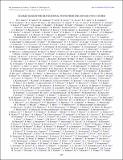STACKED SEARCH FOR GRAVITATIONAL WAVES FROM THE 2006 SGR 1900+14 STORM
Author(s)
Barsotti, Lisa; Blackburn, Lindy L.; Bodiya, Timothy Paul; Brunet, G.; Cao, J.; Corbitt, Thomas R.; Donovan, Frederick J.; Duke, R.; Evans, Matthew J.; Foley, S.; Fritschel, Peter K.; Goda, K.; Grimaldi, F.; Harry, Gregory; Hughey, Brennan J.; Katsavounidis, Erotokritos; MacInnis, Myron E.; Markowitz, Jared John; Mason, Kenneth R.; Mavalvala, Nergis; Mittleman, Richard K.; Sarin, Pradeep S.; Shapiro, B.; Shoemaker, David H.; Smith-Lefebvre, Nicolas D.; Stein, A. J.; Stein, L. C.; Waldman, S. J.; Weiss, Rainer; Wipf, Christopher; Zucker, Michael E.; ... Show more Show less
DownloadAbbott-2009-STACKED SEARCH FOR G.pdf (3.385Mb)
PUBLISHER_POLICY
Publisher Policy
Article is made available in accordance with the publisher's policy and may be subject to US copyright law. Please refer to the publisher's site for terms of use.
Terms of use
Metadata
Show full item recordAbstract
We present the results of a LIGO search for short-duration gravitational waves (GWs) associated with the 2006 March 29 SGR 1900+14 storm. A new search method is used, "stacking" the GW data around the times of individual soft-gamma bursts in the storm to enhance sensitivity for models in which multiple bursts are accompanied by GW emission. We assume that variation in the time difference between burst electromagnetic emission and potential burst GW emission is small relative to the GW signal duration, and we time-align GW excess power time-frequency tilings containing individual burst triggers to their corresponding electromagnetic emissions. We use two GW emission models in our search: a fluence-weighted model and a flat (unweighted) model for the most electromagnetically energetic bursts. We find no evidence of GWs associated with either model. Model-dependent GW strain, isotropic GW emission energy E GW, and γ ≡ E GW/E EM upper limits are estimated using a variety of assumed waveforms. The stacking method allows us to set the most stringent model-dependent limits on transient GW strain published to date. We find E GW upper limit estimates (at a nominal distance of 10 kpc) of between 2 × 1045 erg and 6 × 1050 erg depending on the waveform type. These limits are an order of magnitude lower than upper limits published previously for this storm and overlap with the range of electromagnetic energies emitted in soft gamma repeater (SGR) giant flares.
Date issued
2009-08Department
Massachusetts Institute of Technology. Department of Physics; MIT Kavli Institute for Astrophysics and Space ResearchJournal
Astrophysical Journal
Publisher
Institute of Physics/American Astronomical Society
Citation
Abbott, B. P., R. Abbott, R. Adhikari, P. Ajith, B. Allen, G. Allen, R. S. Amin, et al. “STACKED SEARCH FOR GRAVITATIONAL WAVES FROM THE 2006 SGR 1900+14 STORM.” The Astrophysical Journal 701, no. 2 (July 30, 2009): L68–L74. © 2009 American Astronomical Society.
Version: Final published version
Other identifiers
LIGO-P0900024
ISSN
0004-637X
1538-4357